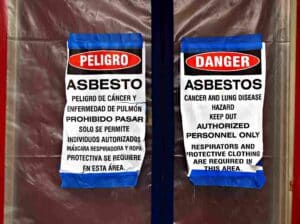
Every year, thousands of Americans are diagnosed with mesothelioma and other asbestos-related health conditions. Although a partial ban in 1989 made it illegal for companies to create products using asbestos and offer them for sale, existing products continue to exist and are utilized daily.
If you have been exposed to asbestos while on the job, our Long Island asbestos exposure attorneys will help you prove your case so you can receive the benefits you are entitled to.
What is Asbestos, and What Products Have It?
Asbestos is a naturally occurring mineral. In the 1980s and early 1990s, this material was hailed as a miracle material due to its durability and heat-resistant qualities. Several products across multiple industries still have products that contain asbestos. Asbestos can be found in several building materials, such as:
- Floor tiles and adhesives
- Insulation (e.g., vermiculite insulation)
- Plaster, joint compound, and spackling
- Roofing materials (e.g., shingles, felt)
- Ceiling tiles
- Cement pipes
In addition, you may find asbestos in automotive products, such as:
- Brake pads and linings
- Clutch facings
- Gaskets
Industrial products can also contain asbestos. Some of the most common include:
- Boilers and pipe insulation
- Fire-resistant clothing
- Gaskets and packing materials
Finally, several consumer products also have asbestos. These include:
- Hairdryers (older models)
- Ironing board covers
- Pot holders and oven mitts
- Certain crayons and children’s toy
Exposure to asbestos can result in an array of health complications.
Dangers of Asbestos Exposure
The problem lies in the microscopic fibers of asbestos that can quickly become airborne when disturbed. These tiny fibers are virtually invisible but possess devastating health risks when inhaled or ingested. They can penetrate deep into the lungs and cause serious diseases. Some diseases or health issues caused by exposure include:
- Persistent cough: A chronic and ongoing cough that may produce mucus or blood.
- Fatigue: Persistent and overwhelming tiredness or weakness that is not alleviated by rest.
- Respiratory issues: Difficulty in breathing, wheezing, or other respiratory problems.
- Clubbing of fingers and toes: Changes in the nails and fingertips, characterized by the nails becoming thicker and wider, often associated with chronic oxygen deprivation.
- Asbestosis: A lung condition caused by inhaling asbestos fibers, leading to scarring lung tissue, which can result in breathing difficulties.
- Difficulty swallowing: A sensation of difficulty or discomfort when swallowing, often indicative of throat or esophageal issues.
- Shortness of breath: Difficulty breathing or a feeling of breathlessness, especially during physical activity.
- Chest pain or tightness: Discomfort or a feeling of pressure in the chest, often associated with breathing difficulties.
- Unexplained weight loss: Significant and unintentional loss of weight, which may be a result of underlying health issues.
- Mesothelioma: An aggressive and often fatal cancer that affects the lining of the lungs, abdomen, or heart, commonly linked to asbestos exposure. Symptoms may include chest pain, difficulty breathing, and abdominal swelling or pain.
Experiencing any of these problems can result in the need for extensive medical care. It may even lead to disabilities, leaving you unable to work again. If you were exposed to asbestos while on the job, our Long Island personal injury attorney can help you prove your case and recover benefits and compensation.
Proving Your Asbestos Exposure Was Work-Related
You will need to take several steps to prove that your asbestos exposure was work-related. If you were exposed to asbestos at a previous job,
- Review your work history: Look back at all your jobs throughout your career. List companies, positions, and locations where you may have been exposed to asbestos.
- Understand industry risks: Certain industries carry a higher risk of asbestos exposure than others. Industries such as construction, shipbuilding, automotive manufacturing, and power generation are known for having higher rates of asbestos use.
- Identify potential sources: Once you know which industries you’ve worked in, identify specific tasks or materials that may have exposed you to asbestos. Common sources include insulation materials, flooring tiles, pipe coverings, and friction products like brake pads.
- Consult medical records: If you have been diagnosed with an asbestos-related illness, review your medical records for any evidence linking the disease to occupational exposure.
- Talk to former colleagues: Reach out to former coworkers who may have witnessed or experienced similar exposures at the same company or worksite.
Our Long Island asbestos exposure attorney can help you gather evidence and build a strong compensation claim. Whether you need to file a personal injury claim or file a claim for workers’ compensation benefits, our team can help.
Call Our Long Island Asbestos Exposure Attorney Today
If you or your loved one was diagnosed with an asbestos-related illness due to exposure at work, it is important to seek justice and hold the responsible parties accountable. At the Law Offices of Joseph J. Perrini, III, we understand the devastating impact that asbestos exposure can have on individuals and their families.
Our Long Island personal injury attorney has successfully recovered millions of dollars in compensation for our clients, and we are dedicated to helping those affected by this negligence. Contact our team today for a free consultation, and let us fight for the justice and compensation you deserve.




